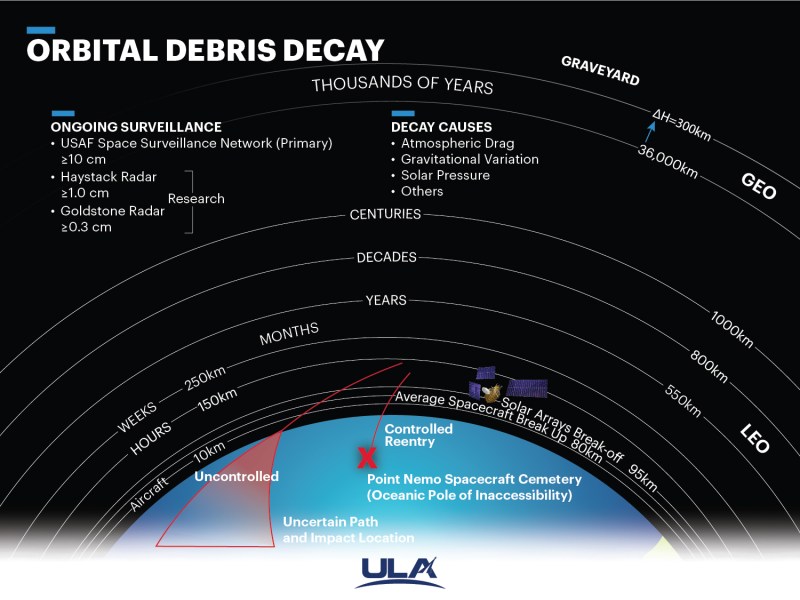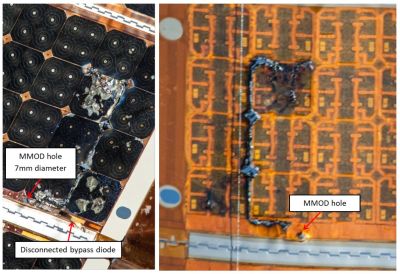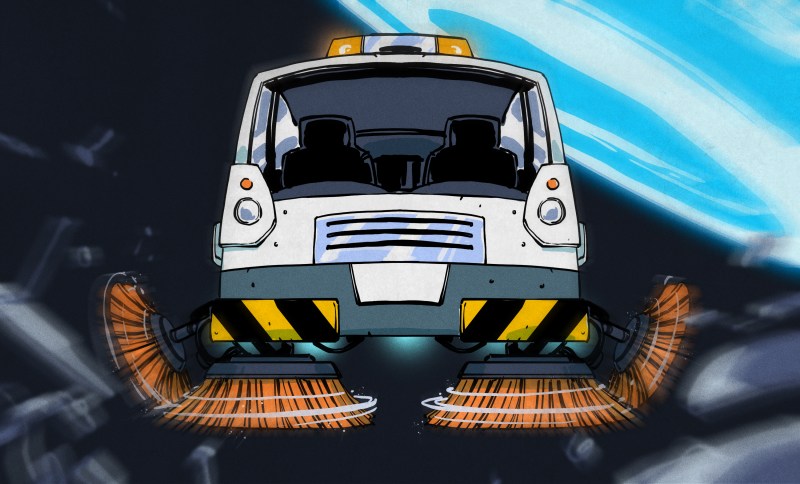Hanging around in earth orbit is like walking into the middle of a Wild West gunfight — bullets are flying around everywhere, and even though none are purposefully aimed at you, one might have your name on it. Many of these bullets are artificial satellites that are actively controlled and monitored, but we also find dead satellites, remnants of satellites, discarded rocket stages, tools lost during spacewalks, and even flecks of paint and rust, much of it zipping around at multiple kilometers per second without any guidance.
While removing this space debris directly would be ideal, the reality is that any spacecraft and any spacesuit that has to spend time in orbit needs to be capable of sustaining at least some hits by space debris impacting it.
Orbital Mechanics
That it’s easy to create new debris should come as no surprise to anyone. What may take a bit more imagination is just how long it can take for this debris to make its way towards earth’s atmosphere, where it will uneventfully burn up. Everything in orbit is falling toward the earth, but its tangential velocity keeps it from hitting — like a marble spinning around the hole in a funnel. Drag from the planet’s atmosphere is the friction that eventually slows the object down, and where it orbits in the planet’s atmosphere determines how long this descent will take.

As cited by NASA’s Orbital Debris Program Office at ARES in their FAQ, there are over 23,000 debris objects larger than 10 cm in orbit, in addition to more than half a million objects between 1 cm and 10 cm, and millions of objects between 1 mm and 10 mm. The principal sources of orbital debris are satellite explosions and collisions. This includes China’s 2007 anti-satellite (ASAT) test, as well as India’s 2019 and Russia’s 2021 ASAT tests, which happened in addition to the USSR & US 57 (total) ASAT tests.
Satellites sometimes explode, such as the 2004 and 2015 US DSMP satellite explosions. Other times satellites collide with each other, like Iridium-33 with Cosmos-2251, get hit by debris or micrometeorites, and so on. As in low earth orbit (LEO) debris tends to travel at speeds upwards of 7 km/s.
Depending on the mass of the debris object, the effect of it impacting with a satellite or other object in its path, likely adding another ~7 km/s into the opposite direction, could be the transfer of gigajoules worth of kinetic energy, equivalent to tons of TNT. Even a fleck of paint traveling at these speeds have been shown to cause significant damage, especially to fragile structures such as solar panels. As mentioned, this makes it essential that such structures can accept some level of impact damage.
Always the Small Ones

Although obviously carrying more energy, the nice thing about the larger debris pieces is that they are relatively easy to track using ground-based equipment. A satellite or space station can use onboard thrusters if it gets too close to the orbit of one of those big pieces of debris.
This then mostly leaves the smaller debris, especially the small flakes and grains that are too small to track, but with enough mass to cause significant damage. For decades, the go-to protection for spacecraft is the Whipple shield. Much like the similar multi-shock shield, it is a type of spaced armor, which is a type of armor first made popular with iron warships of the mid-19th century.
Instead of simply making armor thicker, multiple layers are used, with empty space or some kind of padding in between them. This saves on weight, while allowing for an incoming projectile to harmlessly dissipate its energy. This same principle can be seen with e.g. the windows on the ISS, which consists out of multiple layers. In the case of the ISS’ Cupola, there are four layers:
- Outer debris pane.
- Two 25 mm pressure panes.
- Inner scratch pane.
The outer pane is supposed to dissipate most of the energy of a strike, with the layer behind it catching the debris cloud, which should be traveling at slow enough speeds that they should do no significant harm. Each window can be replaced in-orbit after fitting an external cover, should they suffer so much damage that replacement is warranted.

For the remaining sections of the ISS, ballistic panels are placed some distance from the primary hull, which are designed to capture and dissipate the energy from micrometeorites and small orbital debris. Meteoroid and orbital debris damage on the ISS has been studied for decades now, with a 2019 paper by Hyde et al. describing recent findings.
An interesting finding is that of damage to the ISS’ Solar Array Wings. In one case an micrometeorite impacted one of the panels and created a 7 mm diameter hole. This destroyed a bypass diode in the panel and caused a current buildup that ultimately resulted in a nearly 40 cm long burn-through along the edges of three cells.
Obviously, protecting solar panels in this environment is anything but easy, as by definition adding protective panels in front of them rather defeats the entire purpose of having solar panels. The ISS has over 250,000 cells, with the expectation that some of them will inevitably be lost over time. In June 2021, astronauts at the ISS installed new solar panels to replace the oldest.
While replacing solar panels like this is a viable option to deal with accumulated damage on a space station, it is less practical for satellites, which should thus have sufficient excess electrical capacity to deal with the loss over time.
Offense as Best Defense
Because the debris in some orbits will hang around for decades or longer, we may eventually reach a point where active removal of this debris becomes a necessity. This is where orbital mechanics and the incredible amount of space in, well, space make things very tricky. Even though the risk of orbital debris is high, because satellites and debris are both moving around quite quickly, the density is very low. That’s why astronauts on the ISS don’t see bits of debris zipping by all the time.
This sparseness makes active debris removal a chore, and explains why recent high-profile missions such as RemoveDEBRIS, ClearSpace-1, and others focus on large debris that travels in previously known orbits. They often require satellites to move within a certain distance from the target, and perform delicate operations. As previously established, the largest threat comes from the debris that cannot be easily tracked, which would thus seem to largely defeat these clean-up methods.
Here perhaps the best method is to not actively hunt these objects down, but to passively catch them using an expansive system, much like how a spider uses a web to catch unsuspecting prey. This is what Russian startup StartRocket with their Foam Debris Catcher has in mind. The use of foam to capture orbital debris is not new, with an ESA report from 2011 also covering the use of foam in depth.
No Littering
Even with mitigation solutions in place, and with orbital debris removal methods being investigated and possibly being deployed over the coming decades, the best thing we can do right now is to prevent making more of a mess. These days, space traffic management is handled primarily by the United Nations Office for Outer Space Affairs (UNOOSA), with national policies following international agreements on preventing orbital debris and other considerations.
The increasing focus on re-usability of spacecraft is a fortunate development. The grandest goal of the US Space Shuttle program — that it would serve as a platform for servicing satellites — never came to fruition beyond servicing Hubble. However, we may hope to soon see an end to the routine discarding of simply leaving entire rocket stages floating around, reducing at least one source of space pollution.















> bullets are flying around everywhere, and even though none are purposefully aimed at you, one might have your name on it.
What’s the old saying? “It’s not the bullet with my name on it that worries me, it’s the millions out there addressed to ‘occupant’ “
it’s the bullet addressed to “to whom it may concern”
The debris is going at 7km/s, but aren’t the satellites in the same orbit also going at 7km/s in the same direction (think almost all orbit eastwards?). So what’s the actual impact speed, or is there more complexity to this?
It’s the ones that aren’t in the same orbit, but happen to be at the same altitude, that you need to be worried about.
Iridium-33 and Cosmos-2251 kissed each other at 11.7 km/s, for example.
I take it this is mainly due to elliptical orbits then? Or are circular orbits at different angles common? Is debris mainly in more elliptical orbits?
How do satellites in intersecting orbits avoid collisions normally – are their orbits plotted out decades ahead to check they’re clear of other satellites?
Not only are orbital planes supercommonly in very different angles to equator, their points where they intersect equatorial plane are supercommonly in very different positions to each other. Launch to a polar orbit e.g. pointed south from Vandenberg at midday and do the same at midnight the same day and you would very rougly get two crafts going in oposite direction at the same orbital plane :D
Thanks, helpful.
The United Galaxy Sanitation Patrol was just a fiction?
What makes you think that?
I heard they suspended service to our Solar System when we fell behind in payments.
So, what we need is a vacuum cleaner
I’ll see myself out…
Several giant blocks of ballistics gel, each with a large magnet in the middle.
Most debris is non magnetic. You don’t orbit steel when aluminum or titanium is better and doesn’t disturb your magnetometers. Ballistic gel is mostly water and nobody is going to orbit water at $10K/kg. There is no solution to this. We will continue to damage this environment just like we’ve done on Earth until it becomes a bigger crisis. Duck and cover.
You´re 100% right. We´ll trash it until it won´t be usable. We´re not able to clean the mess down there where it´s not only possible but not even that expensive to do, who can reasonably expect that we´re going to clean up there where it´s way more costly and inaccessible.
that´s it, we´ll enjoy satellite internet for a while, and then it will be game over.
I am so glad that you can see the future so clearly – “We’ll trash it until it won’t be usable”. I think that many people have had similar viewpoints and, so far, they seem to have got it largely wrong. Compared with almost any view of the past, we seem to be doing really well. We have a world where the food supplies, the healthcare and the general freedom from disease and disasters are all becoming more available. I expect that you (VIB) live in a house which is warm, dry, has electricity, clean water and sewage disposal and all these facilities are normally there and work. You obviously have access to the internet and, probably therefore, a computer. I wouldn’t want to do the same as you do and make assumptions about anything but I’d be surprised if you didn’t have some personal transportation, some education and the ability to direct your future in significant ways.
All of these things are so far away from anything that the average person had even 50 years ago let alone 150 years. I am old enough to remember no hot water taps in the house where I lived, a bath once a week and only one house with a telephone in the 200 or so wishing walking distance. And frost on the inside of the windows when I got out of bed to go to school. And this was in 1964.
Education and optimism have been the drivers for change not whining about how bad the world is and how it’s getting worse all the time. Entirely because of education, I can read, write intelligible English, do quite complicated sums and, most of all, evaluate information for truth and bias and not indulge in self reinforcing thinking. What a gift to have been given. Perhaps it needs to be more widely exercised by those of us here.
Please, please try to look at life with a little optimism – most of us reading this are engineers or at least have some science training. We can see problems but we can also see and implement solutions.
And, if you feel that I am being too trite, please look at a book called “The Limits to Growth”, written in 1972. It was (and still is) full of doom – millions of people dying of starvation, disasters and disease everywhere and the population of the earth falling by billions. I ask you to consider how much of this has actually happened. And why it hasn’t
I realise that not everyone has my first world advantages – but if we want to we can make this happen.
Should Kessler syndrome ever become a reality, it’s likely we’ll just send up a giant block of material that will remain intact even when hit with hypersonic debris. It’s really the nuclear option of cleaning up orbit because it will take down absolutely everything.
No, the giant block of material will be shredded by the debris, creating more debris!
B^)
Not a single chance that will happen.
Sending that giant block will have an even more giant cost that nobody will want to afford, rejecting responsibility on each other like the climate change.
The speed humanity is hurling into the wall is not even fully acknowledged. Things might look acceptable on the surface for some time more, but the backslash will be dramatic. The same way the south pole is melting from under, out of view, until it will desegregate. Brutally at the historic scale, in a glimpse at the geological scale, and pretty fast at the scale of a human lifetime.
Well, may be catching an asteroid and driving it to orbit the earth can be cheaper.
But you know how it went to the dinosaurs when they tried…
The US is mentioned multiple times. Perhaps you need to read more carefully.
Thanks! You are a great parser. I was not even able to extract this info by reading the article. Shame on me.
Please don’t feed the trolls!
(I might be in that category! )
B^)
FYI, referenced but not mentioned, the ARES site has the “Orbital Debris Quarterly Newsletter” which makes for fascinating reading and is quite accessible. If this subject interests you, I would argue it’s a must-read. Articles range in their level of detail, so you’ll certainly find something at your level of knowledge.